The Great Debaters
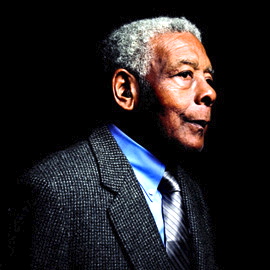
Malcolm X: Speeches and Interviews (1960-65)
A compilation of Malcolm X interviews and speeches 1960-1965.
The Great Debaters
A champion debater in his youth, William Neal Brown knew how to win an argument. Years later, as a professor at Rutgers, he would face his most daunting opponent.
By Paul Hond
In late October of 1961, William Neal Brown ’50SW, a professor of social work at Rutgers, received an urgent telephone call from his friend Clyde Ferguson. Ferguson, a Rutgers law professor, had been scheduled to take part in a debate the following week on the Rutgers-Newark campus with Malcolm X, the fiery Black Muslim orator from Harlem. The topic was to be “Integration or Separation.”
But now, Ferguson told Brown confidentially, he would have to pull out. It seemed that Ferguson, who was serving as general counsel for the U.S. Commission on Civil Rights, and who would later become U.S. ambassador to Uganda, had received a call from the White House, advising him that if he appeared with Malcolm X his career in public service would be jeopardized. “I need a replacement, Neal,” Ferguson said. “I asked the students for ideas, and they all said, ‘Get Brown.’”
This vote of faith meant a lot to Brown. With no political aspirations of his own to protect, and with just days to prepare, he agreed to pinch-hit for Ferguson.
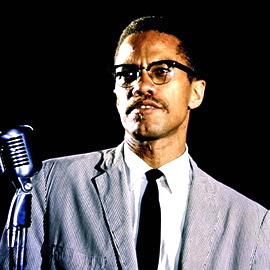 Malcolm X
Malcolm X
A fool’s errand, some said. Malcolm X — former street hustler and now national spokesman for the Nation of Islam — was a bold, forceful, deeply charismatic speaker with a piercing intellect and a reputation for demolishing his PhD’d opponents. In his furious indictment of racist white America and the “anemic” mainstream black leadership, Malcolm had tapped into something powerful in the psyche of poor and working-class blacks, and like any true revolutionary, he made his rivals seem hopelessly outdated.
But Neal Brown had reason to be confident. During his undergraduate days at Hampton Institute, the historically black college in Virginia, Brown was the star of the debating team, which had traveled the East Coast and gone head-to-head with the teams at Harvard and Yale.
“I became a really big man on campus,” he said recently in his home in Millburn, New Jersey. “The debating team got as much support as the football team.”
Brown’s self-assurance was reinforced by his membership in the Tuskegee Airmen, the elite all-black flying unit with whom Brown served stateside during World War II. Brown had trained as an officer, and as he rose through the ranks to captain he gained an appreciation for military meritocracy. Once, while Brown was traveling in the South as a second lieutenant, two white soldiers failed to salute him as he passed. Brown stopped them and took them aside. “You don’t salute me,” he told them, pointing to his shoulder. “You salute these gold bars. You don’t salute a man of any color; you salute his rank.” The soldiers saluted.
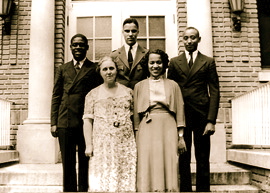 Neal Brown (left) with the Hampton Institute debating team, circa 1939.
Neal Brown (left) with the Hampton Institute debating team, circa 1939.
Not every incident ended as neatly. Brown endured the everyday outrages of racism and segregation, both as an officer and as a civilian. He was called names, was forced to ride at the back of the bus, and more than once was disrespected by a white officer. But the landmark legal blows to segregation in the postwar period encouraged Brown, and as the ’60’s were dawning over the Kennedy White House, Brown held firm to his belief in the remedial powers of the Constitution and the courts. He was not about to cede, to separatists of any race, the hard-fought ground that had been gained.
“Dr. Brown is an extraordinary individual,” says Manning Marable, professor of public affairs, political science, history, and African-American studies at Columbia. “It’s very difficult for us to appreciate the challenges that faced Negro educators, administrators, and scholars at that time. There were no role models to speak of. Affirmative action didn’t exist. But Brown was there, though many of his colleagues would refuse to invite him to dinner, or have him in their church. He could barely live in their neighborhoods without being harassed.”
By 1961, a hundred years after the outbreak of the Civil War, social and economic conditions for the majority of blacks remained dismal. Throughout America, and particularly in the South, blacks were routinely brutalized by the police, terrorized by the Ku Klux Klan, and exposed daily to the dehumanizing realities of segregation. Many had lost hope of ever gaining equality under the American system; for them, Malcolm X’s appeal for a separate black nation within the United States had an irresistible seductiveness.
Brown took a different view. For him, integration was the true revolutionary idea, and he saw evidence that the train, though moving slowly, was on the right track. In 1948, the year Brown entered the Columbia School of Social Work, President Harry S. Truman signed Executive Order 9981, dismantling military segregation. Six years later, the Supreme Court, in Brown v. Board of Education, rejected the “separate but equal” doctrine and ordered the desegregation of public schools. (Malcolm X often mocked the hollowness of that ruling, as schools in the South remained overwhelmingly segregated into the 1960’s.) In 1955, the arrest of Rosa Parks, who refused to give up her seat on a bus to a white man, touched off the Montgomery Bus Boycott, a massive yearlong protest that culminated in the Supreme Court’s upholding a federal court decision that declared Alabama’s segregation laws for buses unconstitutional. And in 1956, Brown himself — the grandson of an ex-slave — became the first black professor in the history of Rutgers.
“There was an ideology among the Negro middle class of being a credit to your race, of racial uplift,” says Marable. “And to a large extent, Brown falls neatly into that category. He had great integrity, a commitment to excellence, and felt that he had to carry on his shoulders the aspirations of an entire race of people.”
William Neal Brown was born in Warrenton, Georgia, in 1919, the son of a poor black farmer and a Native American mother. When he was five, his family moved north to Aliquippa, Pennsylvania, where his father found work in the steel mill that would employ him for the next 47 years.
Brown’s mother had insisted that he attend integrated schools. At age 16, Brown graduated first in his high school class, but was barred from the National Honor Society because of his skin color. He had no money for college, and with the Depression at full tilt, he joined the Civilian Conservation Corps, a relief program established by President Franklin D. Roosevelt in 1933. Brown worked on construction and forestry projects in Virginia, making $30 a month, most of which he sent home to his family.
One day, Brown was approached by an educational adviser at the camp who said he needed a typist in his office. Brown jumped at the chance. The adviser saw something in Brown and introduced him to the dean of men at nearby Hampton Institute. The dean got Brown enrolled in a work-study program. Brown worked on campus by day and took classes at night, and was able to pay his way through college.
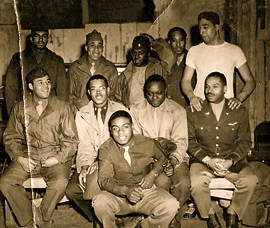 Brown (front row, center) with some fellow Tuskegee fliers, 1943.
Brown (front row, center) with some fellow Tuskegee fliers, 1943.
Brown graduated in 1941, and like most Americans, he was dismayed by the Japanese attack on Pearl Harbor that December. He enlisted in the U.S. Army Air Corps and arrived at Tuskegee in 1942. (Last March, Brown was among 350 Tuskegee Airmen and widows who collectively received the Congressional Medal of Honor at a ceremony in Washington.) A few months after the war ended, the mayor of Englewood, New Jersey, wrote to the Army requesting the services of a military man who could work with young boys who’d had scrapes with the law. Someone said to get Brown. Captain Brown got his discharge and headed north to Englewood. Two years later, through the GI Bill of Rights, he was able to buy a house and study social work at Columbia.
During his Columbia studies, Brown was assigned as a caseworker at the Veterans Administration in Newark. Within three years he himself became a supervisor of students, and it was in the course of meetings with other supervisors at Rutgers that Brown’s name came to the attention of Rutgers administrators. Brown was hired as an associate professor in the graduate school of social work and taught at Rutgers until retiring as professor emeritus in 1989.
Though intensely concerned with the problems facing black people in America, Brown was not an activist in the popular sense of the word. While others took part in sit-ins and Freedom Rides, Brown plied a quiet, unsung trade in the improvement of the mind: counseling emotionally troubled war veterans, lending his expertise in juvenile psychology to state agencies in New Jersey, and, in the lecture hall, fusing the work of Freud and Erikson in his course in human growth and development.
On the evening of November 3, 1961, Professor Brown drove from his home in Montclair, New Jersey, to the gymnasium of the Rutgers School of Pharmacy on Lincoln Avenue in Newark. Hundreds of people had packed the gym to hear the master rhetorician, Malcolm X.
When Brown arrived, he was met by a curious sight. Filing into the building two by two, in something like military cadence, was an endless regiment of young black men, all dressed in black suits, white shirts, and black bow ties. Brought to the event in six buses by the Nation of Islam, the “Fruit of Islam,” as the young men were called, had a vaguely perplexing effect on Brown as they filled up the last rows in the back of the gym.
“Whenever Malcolm X talked, they stood at attention,” Brown remembered. “When I talked, they sat down.”
What Brown didn’t know was that the Nation of Islam had a vital stake in this particular debate. The Chicago-based organization had established mosques in cities throughout the United States, including Malcolm X’s Mosque Number 7 on West 127th Street in Harlem, but it had yet to build one in New Jersey. The Nation hoped the debate would rally local support for that cause.
“The Negro community of Newark had a long history of being attracted to black nationalist sects,” says Marable, who is writing a biography of Malcolm X titled Malcolm X: A Life of Reinvention (Viking, 2009). “The best example is the Moorish Science Temple, founded in 1913 by Noble Drew Ali. Thousands of blacks in Newark were members, and still are to this day. Another thing that characterized Newark was rigid racial segregation — much more rigid than New York City — and the domination of a white ethnic elite over the black community. The Nation looked at Newark and said, ‘This is an ideal place.’”
With a reel-to-reel tape recorder rolling, Brown and Malcolm X put on a riveting polemical clinic that lasted over two hours. Brown, speaking extemporaneously with poise and eloquence, hung tough against Malcolm, whose mandarin politeness barely masked his contempt for the “Uncle Tom” Negro leadership that Brown was presumed to represent.
“Malcolm’s strategy from ’59 to around ’63 was to delegitimate the black middle-class leadership,” Marable says. “He was pushing for what you could call a black coalition or a united front — not from the leadership, but from the grass roots. His goal was twofold: to criticize the mainstream black leaders like James Farmer of CORE and Roy Wilkins of the NAACP, and also to reach out to average working-class blacks to say, ‘Follow us instead. We can voice your concerns far better than a Roy Wilkins or a Professor Brown.’”
Professor Brown, of course, was not so much a black leader as a stand-in for one, but that didn’t stop Malcolm from trying to pin on Brown’s tweedy lapels the emasculating label of “professional Negro.” At one point, Malcolm described the “modern Uncle Tom” as one who “speaks with a Harvard accent, an Oxford accent, and sometimes a Rutgers accent.” The line drew laughter and applause. Brown coolly dismissed Malcolm’s barbs as part of a “canned speech” that Malcolm had delivered in other cities and that served to distract from Brown’s points about the logistical impracticalities of creating a separate black state.
“I was a talented debater,” Brown said many years afterward. “I figured I could take Malcolm X.”
Whether he did or not is a matter of opinion.
“Brown’s perception is that he won the debate,” Marable says. “But if you had done a poll, I think that 90 percent of the people in the audience would have said that Malcolm won hands down.”
At the conclusion of the program, a PR person from Rutgers handed Brown the reel-to-reel tape of the event. Brown put the tape in his briefcase, and as he left the building he bumped into Malcolm X. “Malcolm said to me, ‘That was really nice. We should do it again in the Polo Grounds,’” Brown recalled with a laugh.
Six days later, Brown received a postcard from Phoenix. The card showed a beat-up wooden shack in the ghost town of White Hills, Arizona. On the back was a handwritten note: It’s better to live in a shack that you own, than in someone else’s mansion. It was signed Malcolm X.
The tape of the debate ended up packed away in Brown’s basement, and eventually forgotten. But three years ago, while going through some boxes, Brown uncovered the decades-old reel. He had never listened to it, and neither had anyone else. Thinking the material might be of historical interest, Brown contacted Columbia in hopes of bringing the document to light. (Please see pages 24 to 31 to read the first-ever published ex cerpts from the opening remarks of Brown and Malcolm X.)
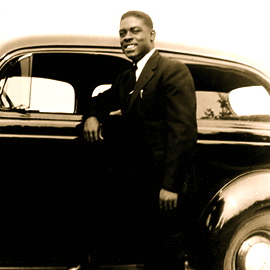 After the war, Brown moved to Englewood, New Jersey, to do social work. He commuted to Columbia in his Pontiac.
After the war, Brown moved to Englewood, New Jersey, to do social work. He commuted to Columbia in his Pontiac.
The 1961 Brown–Malcolm X debate at Rutgers had a chillingly ironic postscript. As a result of the excitement generated by the event, the mosque that the Nation of Islam had envisioned in Newark was opened within a month. The mosque’s ultraconservative leadership, however, came to revile Malcolm X for his willingness, starting in the early 1960s, to work with the civil rights movement (culminating in his break from the Nation in 1964), and for his philosophical shift from racial separatism to a broader political humanism.
On February 21, 1965, three days after giving what would be his last public speech in the LeFrak Gymnasium at Barnard, Malcolm X was attacked inside the Audubon Ballroom in Washington Heights by several men who shot him repeatedly at close range. One man imprisoned for the murder, Talmadge Hayer, and two others whom Hayer implicated but were never arrested, had links to Temple Number 25 in Newark — the very mosque that the Brown-Malcolm X debate had helped to establish.
Neal Brown might not have won a popularity contest that night in Newark in 1961, but history will note that in the end it was Malcolm X who moved closer to Brown’s point of view, and not the other way around. Now, at 88, Brown is enjoying a sudden bestowal of laurels. Aside from being awarded the Congressional Medal of Honor, Brown also received, in 2007, a Congressional Gold Medal from New Jersey senator Frank Lautenberg, as well as an Essex County executive proclamation citing Brown as “a courageous pioneer in breaking down racial barriers and promoting equality.”
Though slowed by age, Brown is still as confident and goaloriented as he was as a young man. He hopes to publish his papers in book form, as a living record of his career as an educator and social worker.
“I’ve had a beautiful life,” he said, “and I have a beautiful life coming up.”
He wasn’t talking about Heaven. To see the complete debate of William Neal Brown and Malcolm X, go to the link below.
http://www.columbia.edu/cu/alumni/Magazine/Winter2008/GreatDebaters.html


